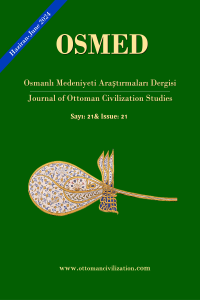Abstract
An atmosphere prevailed among the Ottoman population in which every individual had the opportunity to express himself, live his own values and display his cultural characteristics. It is possible to see this in the performance of different rituals, wearing different clothes, and the diversity of habits. The titles used by individuals belonging to different social layers in the Ottoman Empire within the framework of their belonging are also an indicator of cultural breadth. In this study, Prof. Dr. The work titled " Osmanlı’da Sosyal Sınıf ve Kimlikler " written by Kudret Altun is introduced. An outstanding album from the "Marsigli Collection", which was created as a result of the efforts of the Italian writer and statesman Luigi Ferdinand Marsigli, on the topics mentioned in the work, is discussed. The work, which provides important information about the functionality of social classes and layers in Ottoman society, also includes data about professional groups. In the work where visuals and short explanatory texts are presented lively, there are also explanations in modern Turkish. " Osmanlı’da Sosyal Sınıf ve Kimlikler " is considered to be an important source in the context of history, as well as a work that can be used at different levels of education. In this respect, it is offered for the benefit of everyone who is interested in our history and culture and the education community.
References
- Altun, K. (2019). Osmanlı’da Sosyal Sınıf ve Kimlikler. Bilge Kültür Sanat Yayınevi, İstanbul.
Abstract
Osmanlı ahalisinde her ferdin kendini ifade etme, kendi değerlerini yaşama ve kültürel özelliklerini sergileyebilme imkânına sahip olduğu bir atmosfer hâkimdi. Bu durumu farklı ritüellerin yapılmasında, birbirinden farklı kıyafetlerin giyilmesinde, alışkanlıkların çeşitliliğinde görebilmek mümkündür. Osmanlı’da farklı sosyal tabakalara mensup fertlerin aidiyetleri çerçevesinde kullandıkları başlıklar da kültürel genişliğin bir göstergesi olarak tebarüz etmektedir. Bu çalışmada Prof. Dr. Kudret Altun tarafından yazılan “Osmanlı’da Sosyal Sınıf ve Kimlikler” adlı eser tanıtılmaktadır. Eserde sözü edilen başlıklara yönelik İtalyan yazar ve devlet adamı Luigi Ferdinand Marsigli’nin çabaları sonucu vücuda gelen “Marsigli Koleksiyonu”ndan seçkin bir albüm ele alınmaktadır. Osmanlı toplumunda sosyal sınıfların ve tabakaların işlevselliği ile ilgili önemli bilgiler veren eser, meslek grupları ile ilgili de verileri içermektedir. Görsellerin ve kısa açıklayıcı yazıların canlılıkla sunulduğu eserde günümüz Türkçesiyle de açıklamalar bulunmaktadır. “Osmanlı’da Sosyal Sınıf ve Kimlikler” tarih bağlamında önemli bir kaynak olmasının yanında eğitim-öğretimin değişik kademelerinde faydalanılabilecek bir eser olarak düşünülmektedir. Bu bakımdan tarih ve kültürümüze merak duyan herkesin ve eğitim camiasının istifadesine sunulmuştur.
References
- Altun, K. (2019). Osmanlı’da Sosyal Sınıf ve Kimlikler. Bilge Kültür Sanat Yayınevi, İstanbul.
Details
| Primary Language | Turkish |
|---|---|
| Subjects | Ottoman Culture and Art |
| Journal Section | Book Review |
| Authors | |
| Publication Date | June 15, 2024 |
| Submission Date | May 15, 2024 |
| Acceptance Date | June 14, 2024 |
| Published in Issue | Year 2024 Issue: 21 |
Indexes
SCOPUS, TÜBİTAK/ULAKBİM TR DİZİN [SBVT]
INDEX COPERNİCUS [ICI], ISAM, SOBIAD and Scilit.

Unless otherwise stated, the articles published in our magazine are licensed under the Creative Commons Attribution 4.0 International (CC BY 4.0) license. All authors and translators who submit texts for publication in the journal are expected to be the sole copyright holders of the submitted text or to have obtained the necessary permissions. By submitting texts to the journal, authors and translators implicitly accept that these texts will be licensed under CC BY 4.0 unless explicitly stated otherwise to the editors at the outset.

